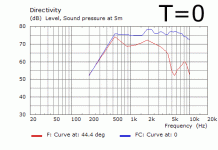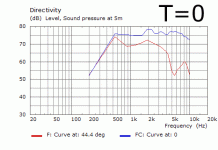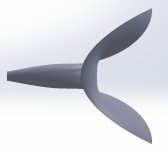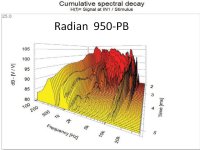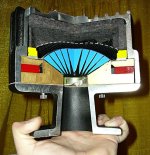A thread to discuss how well a compression driver matches the profile of a particular horn, and how to determine that match - or mismatch.
When choosing a compression driver to go with a particular horn, what is important to know so that the two work well together? Can any driver be used with any horn? Or do some compression drivers work well certain horns and not well with others?
EDIT: April 19, 2023
Attached to this post you will find a spreadsheet, kindly provided by @marco_gea, that allows you to calculate and see the match between a given horn and driver. The spreadsheet takes the parameters of the compression driver throat and calculates an exponential horn that has an equivalent flare rate to the driver throat. With that information you can calculate and see how well a certain expo or hypex horn will match the driver's initial flare rate.
Instructions are included in the spreadsheet.
Obviously the first thing we would look at when choosing a compression driver for a horn is "are they the same size?" In other words, is it a 1", 1.4", 1.4" or 2" entrance to the horn? We normally choose a driver of the exit size as the horn throat. Also to be considered would be the mounting style, such as screw or bolts and the bolt pattern. Adapters can be used for different mount styles and even sizes. For example a common adapter is to use a 1.4" exit driver on a 2" entrance horn. PRV even make a 1" to 2" adapter. But beyond those obvious mechanical matching issues, will a certain driver work well or poorly with a different horn? And how can we determine that for a good match? How do we know the internal geometry of a particular driver?



Horns come in many shapes, sizes and profiles. We might look at a Smith horn that has no vertical expansion at all, but a wide horizontal expansion, to a Kilpsch horn with a long narrow vertical expansion and somewhat wide horizontal expansion - to a long horn that looks somewhat like a trumpet, to the Yuichi and others with mixed expansion.



I'll cite a recent example. Forum moderator @kevinkr recently went thru a good deal of trouble and expense to learn what driver works best for his new Yuichi horns. The Yuichi is a wide horn, but not very tall. In fact the horn very quickly goes to over 90° flare in the horizontal axis, while remaining with zero expansion along the vertical axis for about half its length. The horn is very much axi-asymetric, as opposed to a round horn where the expansion is axi-semetric. Is the horn a rapid expansion, narrow, or somewhere in between? What driver geometry would work best on this horn?
This is what the Yuichi looks like inside.


When choosing a compression driver to go with a particular horn, what is important to know so that the two work well together? Can any driver be used with any horn? Or do some compression drivers work well certain horns and not well with others?
EDIT: April 19, 2023
Attached to this post you will find a spreadsheet, kindly provided by @marco_gea, that allows you to calculate and see the match between a given horn and driver. The spreadsheet takes the parameters of the compression driver throat and calculates an exponential horn that has an equivalent flare rate to the driver throat. With that information you can calculate and see how well a certain expo or hypex horn will match the driver's initial flare rate.
Instructions are included in the spreadsheet.
Obviously the first thing we would look at when choosing a compression driver for a horn is "are they the same size?" In other words, is it a 1", 1.4", 1.4" or 2" entrance to the horn? We normally choose a driver of the exit size as the horn throat. Also to be considered would be the mounting style, such as screw or bolts and the bolt pattern. Adapters can be used for different mount styles and even sizes. For example a common adapter is to use a 1.4" exit driver on a 2" entrance horn. PRV even make a 1" to 2" adapter. But beyond those obvious mechanical matching issues, will a certain driver work well or poorly with a different horn? And how can we determine that for a good match? How do we know the internal geometry of a particular driver?
Horns come in many shapes, sizes and profiles. We might look at a Smith horn that has no vertical expansion at all, but a wide horizontal expansion, to a Kilpsch horn with a long narrow vertical expansion and somewhat wide horizontal expansion - to a long horn that looks somewhat like a trumpet, to the Yuichi and others with mixed expansion.
I'll cite a recent example. Forum moderator @kevinkr recently went thru a good deal of trouble and expense to learn what driver works best for his new Yuichi horns. The Yuichi is a wide horn, but not very tall. In fact the horn very quickly goes to over 90° flare in the horizontal axis, while remaining with zero expansion along the vertical axis for about half its length. The horn is very much axi-asymetric, as opposed to a round horn where the expansion is axi-semetric. Is the horn a rapid expansion, narrow, or somewhere in between? What driver geometry would work best on this horn?
This is what the Yuichi looks like inside.
Attachments
Last edited:
Most of us are aware that compression drivers have different exit angles, either wide or narrow. Sometimes this information is published by the manufacturer, other times it can be found thru various sources on the web. Does the exit angle (and depth) of the compression driver throat make a measurable and audible difference when coupled to a horn?
Let’s take @kevinkr example of different drivers on the Yuichi horn. The first driver tested was a brand new pair of Radian 950-PB. This is a modern style driver with a shallow throat and somewhat wide exit angle of 21°.

How well did this driver perform on the Yuichi horn? Not horrible, but below expectations and not as good as some published measurements of the horn. Here is the Radain 950 on the Yuichi.

A good response with low distortion, but not as good as it might be. The dip circa 1kHz was troublesome and difficult to EQ out. Top end drop off is not unusual, but could perhaps be better.
The JBL 2441 is a 2” driver of similar construction to that of the TAD-4001. Here is a comparison of the 950-PB (orange) and the JBL (red) on the Yuichi.


But contrast, here is the TAD-4001 on the same horn. Red race is with EQ, green trace no EQ. Response is flatter than previous drivers with fewer artifacts. Low end response is good. I’ll let Kevin elaborate on his efforts to get a good response out of each driver on the same horn. Maybe Kevin can combine these three different driver onto one FR plot.

How would we know ahead of time if a driver might but suited to a particular horn profile or not?
To me the Yuichi looked like a horn with a very fast flare rate, that might work well with using a driver with a short, wide throat. But in this case it didn’t. @Arez and some others have pointed out that it’s the combined horizontal and vertical expansions that matters. The overall expansion. See here:
https://www.diyaudio.com/community/threads/best-compression-drivers-today-2022.382609/post-7311398
Let’s take @kevinkr example of different drivers on the Yuichi horn. The first driver tested was a brand new pair of Radian 950-PB. This is a modern style driver with a shallow throat and somewhat wide exit angle of 21°.
How well did this driver perform on the Yuichi horn? Not horrible, but below expectations and not as good as some published measurements of the horn. Here is the Radain 950 on the Yuichi.
A good response with low distortion, but not as good as it might be. The dip circa 1kHz was troublesome and difficult to EQ out. Top end drop off is not unusual, but could perhaps be better.
The JBL 2441 is a 2” driver of similar construction to that of the TAD-4001. Here is a comparison of the 950-PB (orange) and the JBL (red) on the Yuichi.
But contrast, here is the TAD-4001 on the same horn. Red race is with EQ, green trace no EQ. Response is flatter than previous drivers with fewer artifacts. Low end response is good. I’ll let Kevin elaborate on his efforts to get a good response out of each driver on the same horn. Maybe Kevin can combine these three different driver onto one FR plot.
How would we know ahead of time if a driver might but suited to a particular horn profile or not?
To me the Yuichi looked like a horn with a very fast flare rate, that might work well with using a driver with a short, wide throat. But in this case it didn’t. @Arez and some others have pointed out that it’s the combined horizontal and vertical expansions that matters. The overall expansion. See here:
https://www.diyaudio.com/community/threads/best-compression-drivers-today-2022.382609/post-7311398
Kevin may want to speak some on the subject of polar responses of the different drivers on the same horn.
My purpose in starting this thread is to learn more about how a driver might be more of less suited to a particular horn, and how to determine that before buying and building.
My purpose in starting this thread is to learn more about how a driver might be more of less suited to a particular horn, and how to determine that before buying and building.
Simulation case - Radian with wide angle throat into Iwata-JMLC horn, T=0 and T=0.8.
file "sim" with conical adapter (see side view)
file "sim1" T0 regular is perfect match
conical adapter makes a dip around Fc or Axidriver artifact
file "sim" with conical adapter (see side view)
file "sim1" T0 regular is perfect match
conical adapter makes a dip around Fc or Axidriver artifact
Attachments
Last edited:
I'll try to find simulation file on archive disk if somone has Axidriver installer. Anyway any sort of adapter or large angle mismatch will create dips on SPL when T is closer to zero. But dip in Radian is cavity inside the VC.
T=0 is needed for good bass extension in case of fullrange in a horn.

T=0 is needed for good bass extension in case of fullrange in a horn.
Last edited:
Yes the 950 PB in stock form, has a resonance at 1050 hz ish, that has been confirmed by several sources.
I suspect it might become worse if you add they're shims for extra excursion ontop?
They're machining tolerances are not as tight as JBL/TAD/Emilar etc.
That is a tradeoff when chasing power handling and cheap production I guess.
They also have no foam/felt damping in the back chamber unlike JBL/TAD again.
The CSD below shows that behaviour quite well. This also has the 10k resonance from the AL diaphragms showing very clearly.
As for the Yuichi it has a slow flare rate, as do "all" the TAD drivers due to the ALnico magnet design. The only exception is the Neo magnet, 4002 without the adapter, that has a short 10 degree exit, after the phase plug in comparsion, as seen below.
I suspect it might become worse if you add they're shims for extra excursion ontop?
They're machining tolerances are not as tight as JBL/TAD/Emilar etc.
That is a tradeoff when chasing power handling and cheap production I guess.
They also have no foam/felt damping in the back chamber unlike JBL/TAD again.
The CSD below shows that behaviour quite well. This also has the 10k resonance from the AL diaphragms showing very clearly.
As for the Yuichi it has a slow flare rate, as do "all" the TAD drivers due to the ALnico magnet design. The only exception is the Neo magnet, 4002 without the adapter, that has a short 10 degree exit, after the phase plug in comparsion, as seen below.
Attachments
Last edited:
So as everyone probably knows Pano and I have been friends for a long, long time. I shared the details of what I was dealing with him and a few other friends. Here is the overlay of the 3 drivers on the same horn. The other channel is identical within the tolerances of the individual drivers. This was the best I was able to do with the overlay. These are nearfield measurements about 5cm from the horn mouth, on axis with no EQ and no crossover.

Last edited:
The 4003 obviously does not have the Alnico mag, a shorter distance, different exit angels but a slow flare rate, and fairly long exit still.As for the Yuichi it has a slow flare rate, as do "all" the TAD drivers due to the ALnico magnet design. The only exception is the Neo magnet, 4002 without the adapter, that has a short 10 degree exit, after the phase plug in comparsion, as seen below.
So does the Pioneer ED 915, and the different versions from Linear technology, which are basically rebranded TADs.
Sorry my time to edit ran out, was busy in the phone .
Last edited:
Excellent Kevin. That goes a good way to understanding that different drivers perform differently on the same horn.
Do we simply say that the TAD-4001 is an excellent driver, or is it just well suited for that horn?
The example of the Radian on the JBL horn is a nice comparison and further begs the question.
Do we simply say that the TAD-4001 is an excellent driver, or is it just well suited for that horn?
The example of the Radian on the JBL horn is a nice comparison and further begs the question.
Unfortunately I thought I had captures of the Radian on the 2380A, but I deleted all of them when I was clearing out my REW folder, I have ones with JBL 2440, but none with the NEO950PB. I don't think I would have missed a 6dB dip in the response, but we'll never know.
So if I'm reading this right, what matters for matching the expansion rate of the compression driver (or exit angle) is the overall increase in cross section in the first part of the horn. It's obvious for an axisymmetric horn, you can see it visually, but for a mixed horn it's better to look at the net increase in area as the sound progresses through the horn.
The Yuichi A290 looks a Smith horn for the first part of the expansion, but avoids the mouth diffraction that characterizes the classical Smith horn by adding a further vertical expansion right where the Smith horn would typically end. There is an echo of the then-contemporary Altec Manta-Ray and JBL Bi-Radial in having a two-part expansion, but with a (rather clever) smoother transition between the two parts.
The Yuichi as a whole has a "slow" expansion compared to modern waveguides, if I'm following this right.
The Yuichi A290 looks a Smith horn for the first part of the expansion, but avoids the mouth diffraction that characterizes the classical Smith horn by adding a further vertical expansion right where the Smith horn would typically end. There is an echo of the then-contemporary Altec Manta-Ray and JBL Bi-Radial in having a two-part expansion, but with a (rather clever) smoother transition between the two parts.
The Yuichi as a whole has a "slow" expansion compared to modern waveguides, if I'm following this right.
Last edited:
See page 16 for one of the first writeups of the Smith horn:
https://worldradiohistory.com/Archive-All-Audio/Archive-Audio/50s/Audio-1951-Jan.pdf
Here's an earlier mention (also page 16), but without construction details:
https://worldradiohistory.com/Archive-All-Audio/Archive-Audio/50s/Audio-1950-Jan.pdf
https://worldradiohistory.com/Archive-All-Audio/Archive-Audio/50s/Audio-1951-Jan.pdf
Here's an earlier mention (also page 16), but without construction details:
https://worldradiohistory.com/Archive-All-Audio/Archive-Audio/50s/Audio-1950-Jan.pdf
Last edited:
Exactly right.So if I'm reading this right, what matters for matching the expansion rate of the compression driver (or exit angle) is the overall increase in cross section in the first part of the horn. It's obvious for an axisymmetric horn, you can see it visually, but for a mixed horn it's better to look at the net increase in area as the sound progresses through the horn.
There are two issues at play:
- 1st, you want to match the expansion rate. Given that the internal throat of virtually all compression drivers (except the very earliest WE ones) is conical, that entails calculating the driver's "exponential equivalent" flare rate, and matching that to the flare rate of the horn (or, in the case of hypex = hyperbolic-exponential horns like the Yuichi's and TAD, the initial flare rate of the horn).
- 2nd, to the maximum extent possible, once you have met condition 1 above, you also want to avoid any abrupt changes in curvature / sharp internal angles, as these exacerbate diffraction.
In purely exponential horns, m = constant throughout the horn expansion.
In hypex horns, m increases monotonically from throat to mouth.
Watching this...
My 12" woofer boxes are slowly coming along and I'm getting closer to settling on some kind of wave-guide for the tweeter. Maybe an "econowave" or something. So I'm weighing up either designing a wave-guide (or horn without the compression chamber) for one of the non-horn tweeters/mid-tweets I have lying around, OR getting a neo compression driver.
Looking at DN07.10LM, there doesn't seem to be a lot of info and plugging in the numbers to Hornresp requires a lot of guessing. All I can see is that the flux density is strong, which seems to help avoid narrow ripples in the response. I can adjust smooth curves with filters.
I'm looking at making it the old-fashioned way with a collection of wooden rings made into a full teardrop box shape. Developing a nice expansion curve may be a nice challenge. I have an idea for an expansion model, based on taking a curve that smoothly transitions between the throat exit angle and a 4pi steradian box exit angle. On a 2d plane, it would look like an 'S' curve -- at some point the expansion decelerates to minimise any sudden impedance changes as the wave exits the box.
Wonder if anyone has any advice on this? All the designs seem to be either copy-pasting someone else's pre-existing horn, or endless playing with FEA style analysis.
My 12" woofer boxes are slowly coming along and I'm getting closer to settling on some kind of wave-guide for the tweeter. Maybe an "econowave" or something. So I'm weighing up either designing a wave-guide (or horn without the compression chamber) for one of the non-horn tweeters/mid-tweets I have lying around, OR getting a neo compression driver.
Looking at DN07.10LM, there doesn't seem to be a lot of info and plugging in the numbers to Hornresp requires a lot of guessing. All I can see is that the flux density is strong, which seems to help avoid narrow ripples in the response. I can adjust smooth curves with filters.
I'm looking at making it the old-fashioned way with a collection of wooden rings made into a full teardrop box shape. Developing a nice expansion curve may be a nice challenge. I have an idea for an expansion model, based on taking a curve that smoothly transitions between the throat exit angle and a 4pi steradian box exit angle. On a 2d plane, it would look like an 'S' curve -- at some point the expansion decelerates to minimise any sudden impedance changes as the wave exits the box.
Wonder if anyone has any advice on this? All the designs seem to be either copy-pasting someone else's pre-existing horn, or endless playing with FEA style analysis.
A strange way to ask for help when the two groups you disparage are the greatest source of useful information you could hope for.Wonder if anyone has any advice on this? All the designs seem to be either copy-pasting someone else's pre-existing horn, or endless playing with FEA style analysis.
It wasn't my intention to disparage anyone. I just want something that falls somewhere in-between, with maximum understanding and results for the available time and resources that I can put in.
If we model the system like a series of conical sections, as the wave exits the first segment, there is then some available space at the fringes for it to expand into. And that's where we get the rotation, and for each subsequent step the expansion has to be referenced to the starting angle of the previous step.
If we draw an exponential curve on a plane, it seems like the axis that's normal to the expansion should actually rotate as the flare progresses. So the expansion would be faster than what would be expected from simplified wave motion purely in the X axis and expansion in the Y axis.Exactly right.
There are two issues at play:
[*] as a reminder: the flare rate (m) is defined at each distance x from the throat as: m = 1/Sx * d[Sx]/dx (rate of change of wavefront area at distance x, divided by wavefront area at distance x).
- 1st, you want to match the expansion rate. Given that the internal throat of virtually all compression drivers (except the very earliest WE ones) is conical, that entails calculating the driver's "exponential equivalent" flare rate, and matching that to the flare rate of the horn (or, in the case of hypex = hyperbolic-exponential horns like the Yuichi's and TAD, the initial flare rate of the horn).
- 2nd, to the maximum extent possible, once you have met condition 1 above, you also want to avoid any abrupt changes in curvature / sharp internal angles, as these exacerbate diffraction.
In purely exponential horns, m = constant throughout the horn expansion.
In hypex horns, m increases monotonically from throat to mouth.
If we model the system like a series of conical sections, as the wave exits the first segment, there is then some available space at the fringes for it to expand into. And that's where we get the rotation, and for each subsequent step the expansion has to be referenced to the starting angle of the previous step.
If you refer to wall continuity, then I agree. A driver claims a plane to spherical wavefront with it's angle specified and throat to match. A continuation should be conical holding the same angle. Anything other than this will be in the hands of the horn designer.is the overall increase in cross section in the first part of the horn.
Conversely...
Where a horn diffracts by continuing to expand (2nd derivative), changing the wavefront, you can only specify a starting angle to expect from the driver. The expansion itself can result in some continuous reflection along it's length, perhaps involving only part of the wavefront.you want to match the expansion rate.
As far as what the driver itself feels, the compression restriction is the more significant factor.
I know what you mean, but picturing it that way doesn't really help.If we draw an exponential curve on a plane, it seems like the axis that's normal to the expansion should actually rotate as the flare progresses. So the expansion would be faster than what would be expected from simplified wave motion purely in the X axis and expansion in the Y axis.
If we model the system like a series of conical sections, as the wave exits the first segment, there is then some available space at the fringes for it to expand into. And that's where we get the rotation, and for each subsequent step the expansion has to be referenced to the starting angle of the previous step.
The wavefronts will be normal to the horn walls at all times.
Assuming that the driver's phase plug does its job correctly, the wavefront will be plane at the phase plug exit.
Then, the internal conical throat will make the wavefront spherical (i.e., a spherical cap with a radius of curvature dependent on the conical throat exit angle).
Instead, radial horns are designed assuming perfectly cylindrical wavefronts. That is a reasonably close assumption, but not a perfect one, of course.
So, the throat adapter (in between the driver's exit and the horn throat) has to somehow force/squish the wavefront from spherical to quasi-cylindrical.
None of this is perfect (as Dr. Geddes would surely remind you, while throwing his hands up in the air ;-) )
But it has worked reasonably well for many decades.
Then, the devil is in the details, and some radial horns (e.g., the Yuichi's) perform better than others (e.g., the early, simpler, purely exponential ones like e.g., Altec's or Fostex's).
Marco.
This is a great thread. There is so much complex stuff going on in the throat of a horn as it interacts with the driver exit geometry. A problem in this area defines the entire acoustical performance of the horn. Especially when the horn needs to reproduce HF, its critical to have no sharp steps, edges or abrupt dimension changes in the throat.
I understand the Yuichi horn has some peculiar design aspects and it sounds like its designed to specifically work with a narrow angled driver. The TD4001 is a remarkable 2" driver, in that it has extended response well past 10k with such a large diameter diaphragm. The 2441 can get close to the performance, but it doesnt sound quite as refined on the Yuichi.
My question is where in the throat adapter does the wavefront in a Yiuchi start expanding in the horizontal plane if it doesn't exactly follow the adapter walls? How would this dictate the required parameters of a suitable driver for this horn other than just exit angle alone?
I understand the Yuichi horn has some peculiar design aspects and it sounds like its designed to specifically work with a narrow angled driver. The TD4001 is a remarkable 2" driver, in that it has extended response well past 10k with such a large diameter diaphragm. The 2441 can get close to the performance, but it doesnt sound quite as refined on the Yuichi.
My question is where in the throat adapter does the wavefront in a Yiuchi start expanding in the horizontal plane if it doesn't exactly follow the adapter walls? How would this dictate the required parameters of a suitable driver for this horn other than just exit angle alone?
- Home
- Loudspeakers
- Multi-Way
- Matching horns to compression drivers, a discussion
